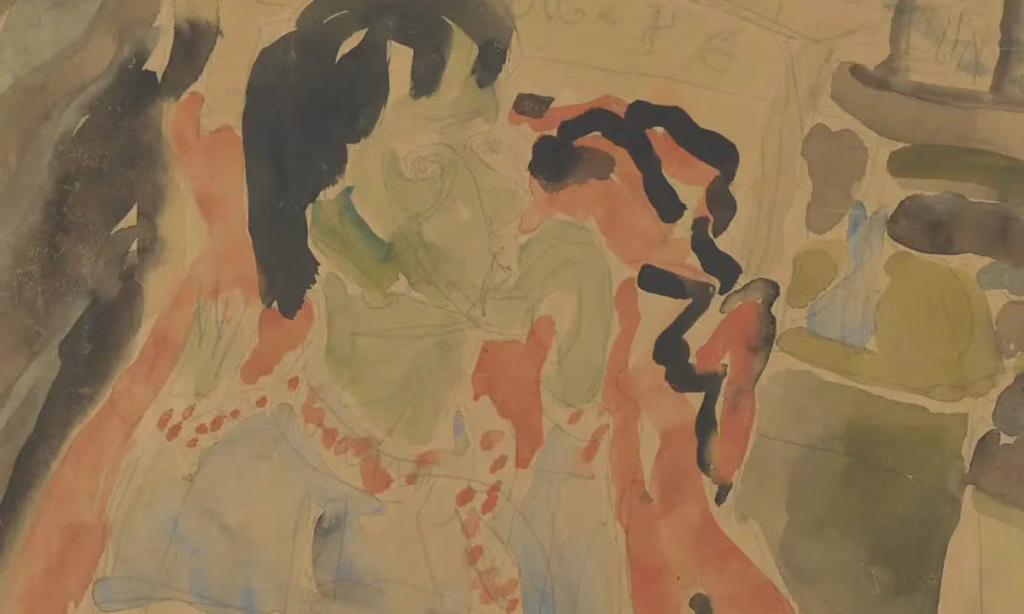The Virginia Museum of Fine Arts (VMFA) has added a treasured work with a troubled provenance into its collection. Im Bett liegender Mann (Selbstbildnis) (Man Lying in Bed [Self-Portrait], 1917-18), a watercolour by the German Expressionist Ernst Ludwig Kirchner, has been donated to the museum’s Ludwig and Rosy Fischer Collection by descendants of the Fischer family after it was voluntarily restituted to them earlier this year by its former owners, Annemarie and Günther Gercken.
The Fischers were eminent collectors in Frankfurt who amassed a world-class trove of German Expressionist art heavily featuring members of Die Brücke, whose penchant for bright, emotive colours and bold gesture overlapped with the contemporaneous French Fauvists. The couple’s sons, Ernst and Max, inherited their collection of around 500 works in 1926.
In 1933, Adolf Hitler passed the Law for the Restoration of Professional Civil Servants, barring “non-Aryans” from positions in the German government and causing Ernst Fischer to lose his position at the University of Frankfurt. He fled Germany with his family and his half of the art collection in 1934, settling in Richmond, Virginia. Max left the following year in the wake of Hitler instating the Nuremberg Race Laws, which stripped Jewish Germans of their citizenship and prevented him from bringing his share of the family art collection with him. After Max’s death in 1954, Ernst tirelessly informed museums and art historians about the lost collection in case the pieces ever came into circulation. As Nazi-era restitution efforts became forefront in the cultural zeitgeist, some of those pieces have come to light.
In 2009, the VMFA acquired the Fischer collection via a gift-purchase agreement with Ernst’s widow, Anne Fischer. Im Bett liegender Mann (Selbstbildnis) is the fourth work to be returned to the Fischer Collection since 2015: another Kirchner, the painting Sand Hills at Grünau (1913), was restituted by the Museum of Modern Art in New York that year; two other works, Taunus Road (1916) by Kirchner and Geschwister (Siblings, 1913) by Erich Heckel, were returned in 2021 and 2020, respectively.
“Having grown up in a home surrounded by these incredible works of art, it was a natural decision to send any restituted works to VMFA, to rejoin the Ludwig and Rosy Fischer Collection at the museum,” Eva Fischer Marx said in a statement. “By reuniting this watercolour with the rest of the collection, we honour our grandparents’ vision and our parents’ dedication to sharing these works with the public.
Kirchner was branded as a “degenerate artist” by the Nazis in 1933 and by 1937 more than 600 of his works had been destroyed or sold against his will. His particular artistic sensitivity to the atrocities of the First World War, described by scholars as his “crisis years” between 1915 and 1918, was stifled by his time in a variety of sanatoriums after he was discharged from a reserve field artillery unit in 1914.
In later life, Kirchner settled in Switzerland. Im Bett liegender Mann (Selbstbildnis) is a study for a 1918 masterwork, Selbstbildnis als Kranker (Der Kranker), which is in the collection of the Pinakothek der Moderne in Münich. The preparatory watercolour now at the VMFA references his nervous breakdown in self-portrait form, depicting his uncoiffed hair and severe facial contours in striking clarity.
“The medium of watercolour produced the sense of a quickly executed, dynamic composition, even if it was a carefully considered image of his illness,” said Sarah Eckhardt, the museum’s associate curator of Modern and contemporary art. “Each work from Max’s portion of the collection which has rejoined the larger Ludwig and Rosy Fischer Collection at VMFA deepens our understanding of Ludwig and Rosy Fischer’s vision as collectors and expands our ability to tell their family’s story.”
The VMFA will organise an exhibition devoted to the Fischer Collection following the completion of an extensive renovation and expansion project.
